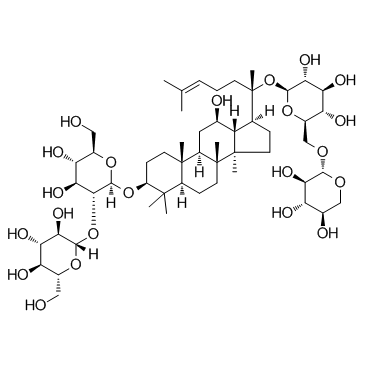Inhibition of NMDA receptors underlies the neuroprotective effect of ginsenoside Rb3.
Liang-Liang Peng, Hong-Mei Shen, Zheng-Lin Jiang, Xia Li, Guo-Hua Wang, Yun-Feng Zhang, Kai-Fu Ke
Index: Am. J. Chin. Med. 37(4) , 759-70, (2009)
Full Text: HTML
Abstract
In order to investigate the mechanisms underlying the neuroprotective effect of ginsenoside Rb3, rat hippocampal neurons were primarily cultured, and exposed to 1 mM N-methyl-D-aspartate (NMDA), cell viability and lactate dehydrogenase leakage were measured. Ca2+ influx was determined by calcium imaging with a laser confocal microscopy. The influences of ginsenoside Rb3 on these variables were examined. Patch-clamp technique was used to observe the effects of ginsenoside Rb3 on NMDA-evoked current. The results show that treatment of Rb3 raised the neuronal viability, reduced the leakage of lactate dehydrogenase, and inhibited NMDA-elicited Ca2+ influx in a dose-dependent manner. In the presence of Rb3, NMDA-evoked peak current was inhibited, and Ca2+-induced desensitization of NMDA current was facilitated. It is suggested that ginsenoside Rb3 could exert a neuroprotective role on hippocampal neurons, a role which was partly mediated by the facilitation of Ca2+-dependent deactivation of NMDA receptors, and the resultant reduction of intracellular free Ca2+ level.
Related Compounds
| Structure | Name/CAS No. | Molecular Formula | Articles |
|---|---|---|---|
 |
Ginsenoside Rb3
CAS:68406-26-8 |
C53H90O22 |
|
[A quantitative method using one marker for simultaneous ass...
2008-12-01 [Yao Xue Xue Bao 43(12) , 1211-6, (2008)] |
|
Ginsenoside Rb3 ameliorates myocardial ischemia-reperfusion ...
2011-09-01 [Pharm. Biol. 49(9) , 900-6, (2011)] |
|
Microbial transformation of ginsenosides Rb1, Rb3 and Rc by ...
2010-09-01 [J. Appl. Microbiol. 109(3) , 792-8, (2010)] |
|
Inhibitory influence of ginsenoside Rb(3) on activation of s...
2005-03-10 [Brain Res. 1037(1-2) , 99-106, (2005)] |
|
Anti-diabetic effect of ginsenoside Rb(3) in alloxan-induced...
2012-09-01 [Med. Chem. 8(5) , 934-41, (2012)] |